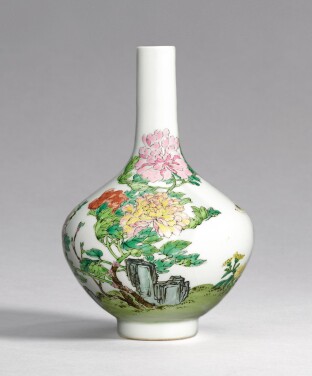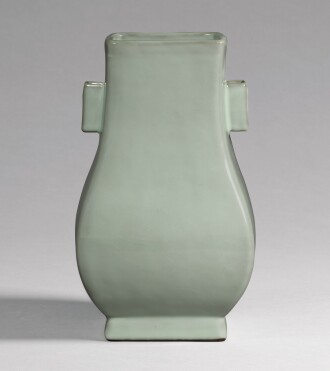L eading our series of sales as part of Asian Art in London 2020 is a collection of fine imperial porcelains carefully assembled by a discerning private collector since the 1970s. Highlights include a rare small flambe-glazed moonflask of the Qianlong period, formerly in the collection of J.M. Hu, the master of the Zande Lou (Studio of Temporary Enjoyment), and a very rare celadon-glazed conjoined vase of the Yongzheng period.

This rare vase is an exceptional example of the technical and artistic perfection achieved at the imperial kilns in Jingdezhen during the reign of the Yongzheng emperor. Its sophisticated form and cool celadon glaze are deeply rooted in the ceramic tradition of the Song dynasty (960-1279) and encapsulate the emperor’s favour for these early wares and his insistence on outstanding quality.
The imperial kiln factory in Jingdezhen experienced one of its most flourishing periods under the watchful eye of the Yongzheng Emperor. The emperor’s love and astute knowledge of the antiques in the imperial collection incited potters to create unique and exquisitely crafted wares that were both technically challenging and steeped in historical symbolism, such as this vase. While conjoined vases were made in ceramic form from as early as the Neolithic period, this piece is more likely to have been inspired by multi-spouted vases and jars popular in the Song dynasty. Made at the Longquan kilns in southern Zhejiang province, these jars were used to store grain in tombs, and were believed to secure the eternal well-being of a family. One such jar was recovered from Suining, Sichuan province, and illustrated in Song yun, Sichuan Jiaocang wenwu jicui [Selected relics from the Sichuan hoards], Beijing, 2006, pl. 36.
Conjoined vases were first made at Jingdezhen during the reign of the Yonzheng Emperor and their form is a testament to the potters’ technical know-how, as they were particularly difficult to fire successfully. During the firing, the proximity of the neck and mouth of the vessels increased the risk of warping. Used for displaying flowers, conjoined vases began to be made early in the Yongzheng reign as can be glimpsed from an entry in Archive of the Imperial Workshop dated to the fourth year of the reign (corresponding to 1726), which mentions five-spouted vase made at the falang (enamelling) workshop on the 7th month of that year, and a six-spouted vase a month later.

This brilliantly enamelled teapot illustrates the continued influence of the Qianlong Emperor at court after his abdication in 1796 and even after his death in 1799. Its form, meticulously painted decoration and composition follows the ornate style developed at the imperial kilns in Jingdezhen that catered to the Qianlong’s taste of the ornate.
The poetic inscription was also composed by the then retired Qianlong Emperor on the 10th lunar month of 1797. Titled ‘Brewing Tea’, the poem is collected in the First Anthology of Imperial Poetry, has been translated by S.W. Bushell as follows:
Finest tribute tea of the first picking
And a bright full moon prompt a line of verse
A lively fire glows in the bamboo stove,
The water is boiling in the stone griddle,
small bubbles rise like ears of fish or crab.
Of rare Ch’i-Ch’iang tea, rolled in tiny balls,
one cup is enough to lighten the heard,
And dissipate the early winter chill.
(S.W. Bushell, Oriental Ceramic Art, London, 1981, p. 239).The art of tea drinking represented a shared passion for the Qianlong and Jiaqing emperors, as attested by the numerous poems they both composed on the subject. The imperial kilns at Jingdezhen produced significant amounts of teawares for the court, including teapots, cups and covered bowls, as well as trays. While the year after the death of Qianlong, the Jiaqing Emperor decreed that porcelain teawares should no longer be inscribed with poems composed by his father, the large quantity of extant examples suggests that they continued to be produced. An entry in the court archives from the 10th year of the reign, lists the order of five pairs of famille-rose teapots, with imperial poems in iron red, most likely this type, that were to be presented at court and sent to the Yuanmingyuan (Garden of Perfect Brightness).











